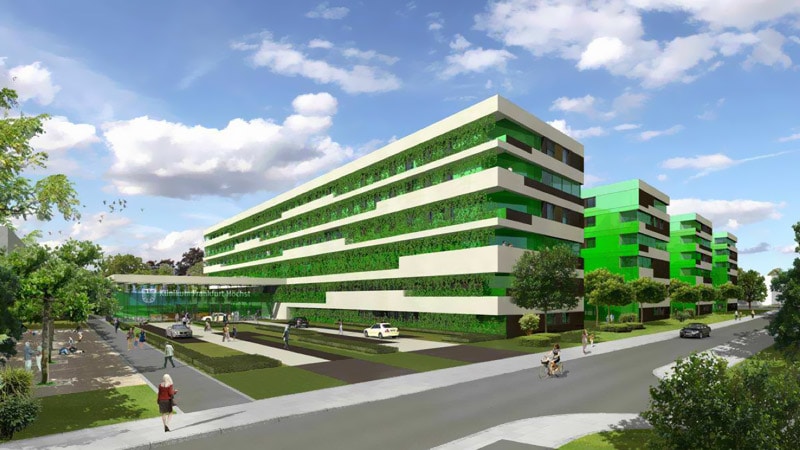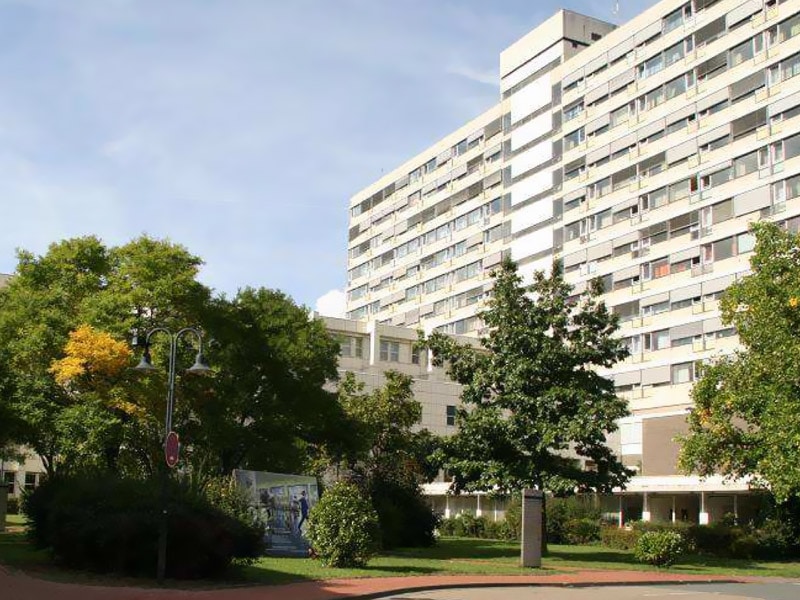Next Trend in Passive House Design: Passive Hospitals
Passive house design has gone from an emerging architectural trend to a firmly established movement that’s entrenched itself in the professional and public mind. Even so, most people – both industry experts and laypeople – take the term literally, and equate “passive house” with, you know, houses. The truth, meanwhile, is that the same principles that guide the design and construction of a passive house can also guide the design and construction of condominiums or, for example, hospitals.
Over in Darmstadt, Germany, the Passive House Standard is being applied to an older, energy intensive hospital in the Hoechst district of Frankfurt. The structure is being totally rebuilt, old machines and systems are being replaced, and the entire focus is on maximum energy efficiency.
It’s an exciting project that kicked off earlier this year (in May, to be precise), and the implications could be global – or, at the very least, could come here to the US, where firms like Kaiser and others are struggling to reduce hospitals’ energy consumption.
Passive House: Also a Maximum Energy Efficiency Solution for Hospitals
Darmstadt, Germany. Hospitals are among the most energy-intensive of building types. Here too, the Passive House Standard provides a solution that results in considerable savings. The time is ripe to take advantage of this finding. In Germany, for example, many of the some 2000 hospitals are currently in need of refurbishment – likely a familiar situation in numerous countries. In the Hoechst district of Frankfurt an older hospital building is currently being replaced by a new build with a focus on maximum energy efficiency. The result will be the world’s first Passive House hospital. Critical issues regarding the execution of this project were elaborated in a baseline study commissioned by the State of Hesse (a compilation of the overall key results of this study is now available online on Passipedia).
The Passive House concept is based on the fundamental idea of significantly reducing the demand for all energy applications while improving comfort at the same time. In a highly complex building such as a hospital, heating is only one of the many energy flows that exert influence. Efficient devices, whether in the form of lighting or medical equipment, not only save energy directly but also reduce the cooling demand at the same time. A hospital’s use profile also places specific demands on the building systems, with hygiene and thus the well-being of patients and staff being the top priority. Passive House proves promising especially in this regard.
Insulation measures are particularly worthwhile in hospital buildings on account of their high temperature requirements and almost continuous operation. Moreover, many areas in conventional hospitals are already equipped with ventilation technology, meaning that equipping the building with large scale controlled heat recovery ventilation is only a minimal addition. The baseline study shows that the heating demand can be limited to 15 kWh per square meter of useful space annually despite the higher indoor temperatures and average air exchange rates. Even at such a high level of energy performance, lighting, ventilation, hot water supply, heating, and cooling constitute the most energy intensive applications. Depending on the technical equipment used in the hospital, autoclaves, magnetic resonance tomography, and data processing can also contribute much to the total energy demand.
As some of the processes in a hospital generate waste heat, it stands to reason that as much of this waste heat as possible should be made use of in other processes, for example, in the heating system by means of a heat pump. Nevertheless, as the results of the baseline study show, the priority should always be given to the optimization of the processes generating this waste heat. All told, the conditions for large-scale energy efficiency measures in hospitals are favorable; with the available technology, the energy demand can be reduced significantly in most areas. In view of the complexity of the energy flows though, consultation and involvement of all stakeholders at an early stage is essential.
In Frankfurt-Hoechst, a highly energy efficient new building will replace the old municipal hospital building. This new build will be executed to the Passive House Standard, in accordance with the Passive House resolution adopted by the City of Frankfurt. The baseline study, commissioned by the German State of Hesse and carried out by the Passive House Institute, draws, in many parts, on the preliminary planning for the new Frankfurt-Hoechst clinic.
Source: Green Building Elements | Images: Passiv.de


